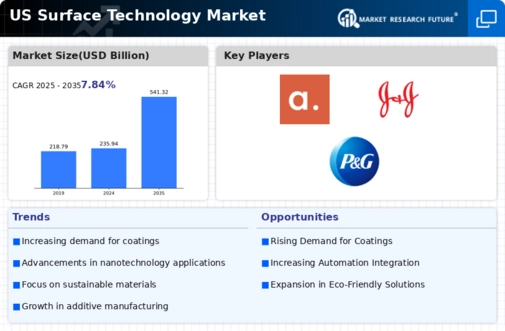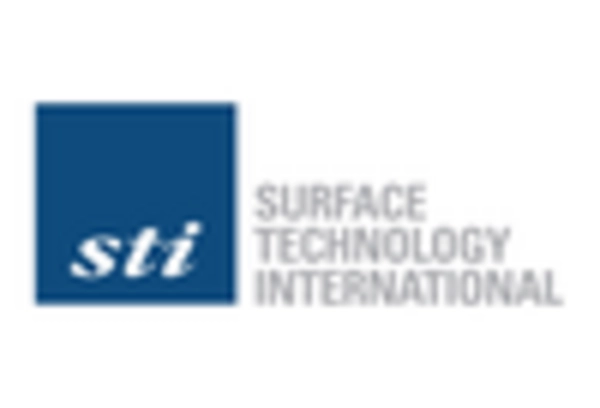Focus on Energy Efficiency
Energy efficiency is becoming a central theme in the surface technology market, as industries strive to reduce their carbon footprint. Coatings that improve thermal insulation and reduce energy consumption are gaining traction. For example, reflective coatings can lower energy costs by up to 30% in commercial buildings. This trend aligns with broader sustainability goals, prompting manufacturers to invest in energy-efficient surface solutions. As regulatory frameworks increasingly favor environmentally friendly practices, the surface technology market is expected to see a shift towards products that not only enhance performance but also contribute to energy savings.
Rising Demand for Corrosion Resistance
Corrosion resistance is becoming increasingly vital in various sectors, including construction and manufacturing. The surface technology market is responding to this demand by developing coatings that provide superior protection against environmental factors. For instance, the use of epoxy and polyurethane coatings has shown to reduce corrosion rates by up to 80%. This trend is particularly relevant in the oil and gas industry, where equipment longevity is critical. As companies seek to minimize maintenance costs and extend the lifespan of their assets, the surface technology market is expected to expand significantly, with a projected market value reaching $15 billion by 2030.
Growth in Aerospace and Defense Applications
The aerospace and defense sectors are pivotal drivers of the surface technology market. With increasing investments in aircraft manufacturing and military equipment, the demand for advanced surface treatments is on the rise. Coatings that enhance wear resistance and thermal stability are particularly sought after. The market for aerospace coatings alone is anticipated to reach $4 billion by 2027, reflecting a robust growth trajectory. This growth is fueled by the need for lightweight materials that do not compromise on strength, thereby propelling innovations in surface technology. As these industries evolve, the surface technology market is likely to adapt and expand accordingly.
Technological Advancements in Coating Processes
The surface technology market is experiencing a surge in technological advancements, particularly in coating processes. Innovations such as plasma spraying and chemical vapor deposition are enhancing the performance and durability of coatings. These advancements are crucial for industries like aerospace and automotive, where surface integrity is paramount. The market is projected to grow at a CAGR of approximately 6.5% from 2025 to 2030, driven by the demand for high-performance coatings. As manufacturers adopt these advanced techniques, the surface technology market is likely to witness increased efficiency and reduced production costs, thereby attracting more investments.
Increased Investment in Research and Development
Investment in research and development is a critical driver for the surface technology market. Companies are allocating substantial resources to innovate and improve existing technologies. This focus on R&D is essential for developing new materials and coatings that meet the evolving needs of various industries. The market is witnessing a rise in collaborations between academic institutions and industry players, fostering innovation. As a result, the surface technology market is likely to benefit from breakthroughs that enhance product performance and application versatility, potentially leading to a market valuation exceeding $20 billion by 2030.

















Leave a Comment